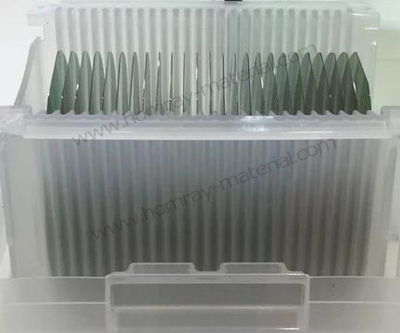
Substrate, the key to the development of silicon carbide industry
The third generation semiconductor uses SiC and gallium nitride (GaN) as the main materials, which is different from the first generation semiconductor which uses Silicon (Si) and germanium (Ge) as the main materials, and the second generation semiconductor uses gallium arsenide (GaAs), indium phosphide (InP) and aluminum gallium arsenide (AlGaAs) as the main materials.
 As the leading manufacturer of SiC substrate wafer, HMT provide test grade SiC substrate with 4 inch and 6 inch both N type and SI type. We also offer research grade SiC substrate and production grade SiC wafer to meet your different requirements of project. The SiC wafer packaged with cassette or single wafer box. HMT runs a strict quality control system involving raw materials selection, production control, SiC wafer inspection, fine packing, and delivery to the desired destination to ensure the company vision.
As the leading manufacturer of SiC substrate wafer, HMT provide test grade SiC substrate with 4 inch and 6 inch both N type and SI type. We also offer research grade SiC substrate and production grade SiC wafer to meet your different requirements of project. The SiC wafer packaged with cassette or single wafer box. HMT runs a strict quality control system involving raw materials selection, production control, SiC wafer inspection, fine packing, and delivery to the desired destination to ensure the company vision.
In high power applications, the third generation semiconductor has wide energy gap, high temperature resistance and high power density characteristics; In high frequency applications, it has the characteristics of low energy consumption and good heat dissipation. Demand for electric vehicles, 5G infrastructure and fast charging are the main growth drivers. SiC transistors and silicon carbide GaN transistors are two products with high growth, annual compound growth rate of 27% and 26%, respectively, need to use SiC substrate.
SiC long crystal efficiency is 100 to 200 times slower than Si, Si long crystal about 3 days to make 200 cm high crystal rod, SiC to 7 days to grow 2 to 5 cm crystal ball. In addition, SiC hard and brittle, cutting, grinding and polishing difficulty is high, there will be a lot of waste. At the same time, the temperature and pressure are not allowed to make any mistakes in the crystal growth process. The crystal growth process is operated in a completely black box environment, during which the crystal changes cannot be observed by naked eyes, and the crystal growth rate is extremely slow.
